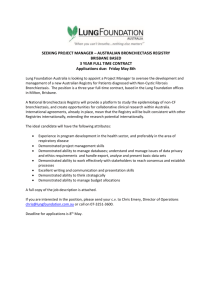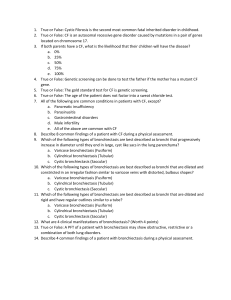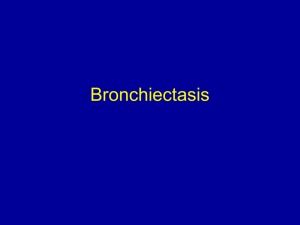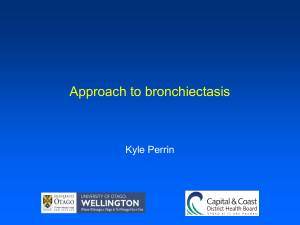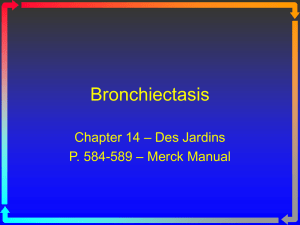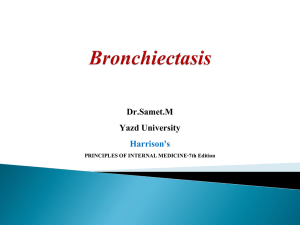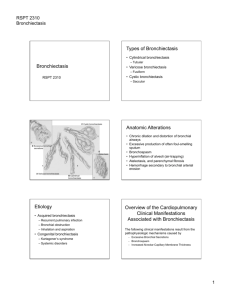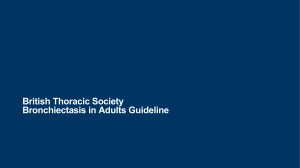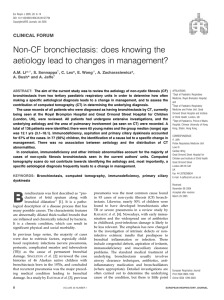DI-Chest
advertisement
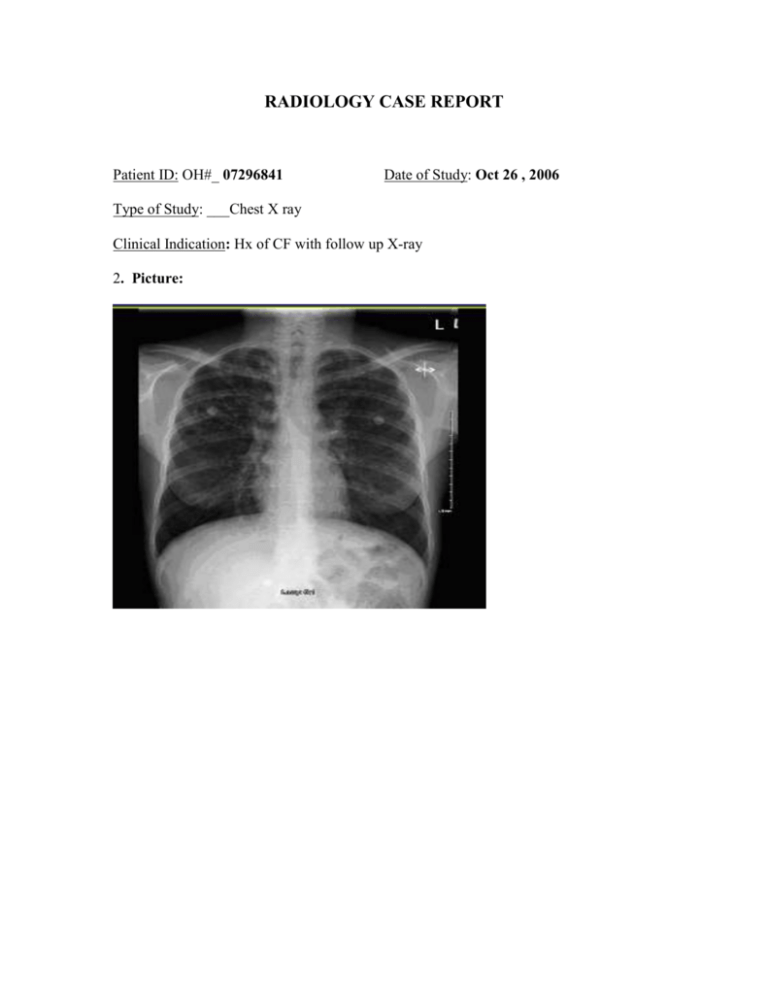
RADIOLOGY CASE REPORT Patient ID: OH#_ 07296841 Date of Study: Oct 26 , 2006 Type of Study: ___Chest X ray Clinical Indication: Hx of CF with follow up X-ray 2. Picture: 2. Describe the radiological findings: Abn findings: Increased opacity mostly in the upper portion of the lungs ( RUL,RML, LUL) (bilat, symmetrical) Mild hyperinflation of the lung ( bilat) : due to air trapping ? Increased lung ( pulmonary) markings ( bilat , RUL>LUL) Some dilation and thinking of the bronchial wall , bilateral ( close to hila) Some flattening of the diaphragm ( bilat) , probably due to hyperinflation linear lucencies and parallel markings radiating from the hila ( R>L) The findings are suggestive of bronchiectasis Normal finding : no tracheal shift , normal cardiac boarders with no cardiomyopathy, no dilation of mediastinum or enlarged lymph nodes , normal costo-phrenic angle, with no sign of pneumothorax (Lung markings should always extend to the very edge of the thoracic cavity 3. Provide possible diagnosis(es): Differential diagnosis of Bronchiectasis included two categories: Congenital and Acquired Acquired type: 1. primary infection that has not been treated or treated poorly especially in TB * 2. secondary to prolonged bronchial obstruction: bronchia tumors, FB 3. autoimmune disease : RA: specially if combined with smoking 4. environmental exposures : inhalation and aspiration of ammonia and other toxic gases, * most common type in acquired categories Congenital: 1. CF**: secondary to mucous plugging of proximal airways and chronic pulmonary infection, especially with P aeruginosa. 2. Kartagener syndrome: Primary ciliary dyskinesia 3. Young's syndrome, is a rare condition which patients will produce thick mucus, usually see the triad of bronchiectasis, rhinosinusitis and reduced fertility 4. alpha 1-antitrypsin **: most common cause of bronchiectasis in general _4. What would you recommend next for this patient? Since there is a Positive Hx of CF, I would recommend the followings: More aggressive chest physio treatment ( disease the mucus build up → decrease seeding of infectious agents → decreases acute infection →decreases the inflammatory changes leading to bronchiectasis. Neobelized DNAse : braking up the build of DNA in the mucus decreases the viscosity of the secretion→ easier to clear the secretion ( usually expensive and need 3rd party coverage) Immunization up to date with yearly flu vaccine Prophylactic antibiotic against P aeruginosa ( only use of Tobramycin Nebs BID is recommended other wise use of prolonged oral antibiotic increases the risk of drug resistance using any acute infection) 5. Is the use of this test/procedure appropriate? Yes. Xray has a very high resolution property. It is relatively safe and cheap. Further more, it is more accessible than any other modalities. It is a relatively sensitive tools for the primary changes seen in patient with CF, however it not very specific test Is(are) there any alternate test(s)? 1. Chest high-resolution computed tomography (HRCT) scan : HRCT is the test of choice for detecting the presence and the extent of bronchiectasis. The test has a sensitivity and specificity of 80%, and 87%, resectvitly, for the detection of bronchiectasis . Based on Reid classification, the 3 forms of bronchiectasis have been described: Varicose bronchiectasis is more irregular with alternating areas of dilatation and constriction of the bronchus. 2. Cylindrical bronchiectasis: which has a parallel tram track lines, with dilated bronchus which may look like a signet ring in horizontal section , an adjacent pulmonary artery represents the stone of the ring 1. 3. Cystic bronchiectasis has a appearance of a big cysts with honeycomb pattern Other common finding: 1. Ratio between the size of bronchus lumen to the size of its adjacent vessel should be between 1-1.5. If the diameter is more than 1.5, the bronchiectasis can be suspected. 2. Atelectasis and consolidation are nonspecific findings. 2. The pulmonary function testing This is a very reliable test for measuring the baseline lung function and for following the progression of disease over time. It is invasive and accessible. The most common abnormality seen is categorized as an obstructive airway diseases however, restriction pattern may be a late presentation with patients observed in patients with severe advanced disease secondary to scarring and atelectasis, , Findings include : Reduced FEV1], : can improve in response to β-agonist bronchodilators Reduced [FVC], and FEV1/FVC);. TLC may be increased or decreased based on the stage if the diseases 7. How would you explain to the patient about the possible risks and benefits of this test? For the chest CT: Benefits CT is fast, painless, noninvasive and accurate. Unlike x-rays, CT provides more detailed images of many types of tissues CT is less sensitive to patient movement than MRI. CT can be performed if patient has implanted medical device, unlike MRI. A diagnosis property of the CT may decrease the need for exploratory surgery and surgical biopsy. No radiation remains in a patient's body after a CT examination. Risks Slight chance of cancer due to radiation exposure, however the effective radiation dose of chest Ct is about 8-10 mSv, which is about the same as the average person receives from background radiation in three years. not recommended for pregnant women unless medically necessary if mom is breast feeding, she should wait for 24 hours after contrast injection, if using contrast, there is always risk allergic reaction to contrast materials and usually can no be used if patient do not have a good renal function. For the PFT: PFT has little or no risk to the patient unless he/she suffers from sever heart or lung diseases which limits his/her ability to take deep/forceful breaths. The procedure is again very safe and non invasive. The test is easily available and can give a significant information about the lung function at any stage of the dieases. 8. What is the cost of this test? PFT : cost any where from 90-150 $ Chest CT : from 500-2500, depending on the location and whether the contrast it used or not The cost is based on US data Ref: 1. Mysliwiec, V, Pina, JS (1999). "Bronchiectasis: the 'other' obstructive lung disease". Postgraduate Medicine 106 (1): 252–63. 2. Emmons, Ethan (2007-01-31). "Bronchiectasis". eMedicine Specialties Encyclopedia. San Antonio, TX: WebMD. Retrieved on 2007-06-22. 3. Morillas HN, Zariwala M, Knowles MR. Genetic Causes of Bronchiectasis: Primary Ciliary Dyskinesia, Respiration 2007 72 (3): 252–63. 5. 4. Dalrymple-Hay MJ, Lucas J, Connett G, Lea RE Lung resection for the treatment of severe localized bronchiectasis in cystic fibrosis patients, Acta Chir Hung 1999 38 (1): 23–5. 5. Handelsman DJ, Conway AJ, Boylan LM, & Turtle JR Young's syndrome. Obstructive azoospermia and chronic sinopulmonary infections, NEJM (1984). 310 (1): 6. .http://www.ljm.org.ly/articles/AOP/AOP080429/Figure5,%20Langerhans.jpg 7. http://www.google.com/search?sourceid=navclient&aq=t&ie=UTF8&rlz=1T4RNWN_enCA218CA219&q=how+much+does+a+chest+CT++cost 8. http://en.wikipedia.org/wiki/Bronchiectasis 9. http://www.emedicine.com/med/topic246.htm 10. Evans DJ, Greenstone M. Long-term antibiotics in the management of non-CF bronchiectasis--do they improve outcome. Respir Med Jul 2003; 97(7):851-8.
